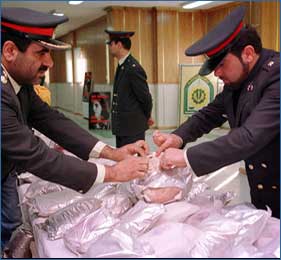
Police officers in Tehran, Iran inspect a bag of Afghan-origin morphine among 1,114 kilograms of morphine seized from drug traffickers. (Photo: Reuters) |
Converting morphine to heroin base, sometimes called “Heroin No. 2,” is more complicated than extracting morphine, but is still a simple process requiring commonly available industrial chemicals and no special tools. The process starts when a mixture of heroin base and acetic acid is heated at 85°C for two hours. During this time, the morphine dissolves. When cooking is completed, the mixture cools and the morphine and the acid chemically bond to form heroin. Next, water is added to the mixture to dissolve the heroin. Sodium carbonate — a common ingredient in soaps — is added to the heroin solution from which finally heroin base results. Depending on the quality of morphine, slightly more than one kilogram of heroin base is made for each kilogram of morphine. Heroin base is further processed into smoking heroin called “Heroin No. 3” or “injectible heroin” called “Heroin No. 4.”
Sources: US Department of Justice, “Opium: A History” by Martin Booth, National Institutes of Health, UNDCP
Heroin Facts
Since many heroin addicts inject the drug, they are at special risk for contracting HIV and other infectious diseases such as hepatitis B and C. Injection drug users can contract HIV by reusing contaminated syringes and needles or other drug paraphernalia by more than one person. Drug abuse by injection is the largest factor for the spread of HIV in the U.S. A study by the National Institutes of Health found that 27 percent of all injecting drug users are HIV-infected.
- Previous: Step 3: Extracting Morphine
- Next: Step 5: Heroin Purification



